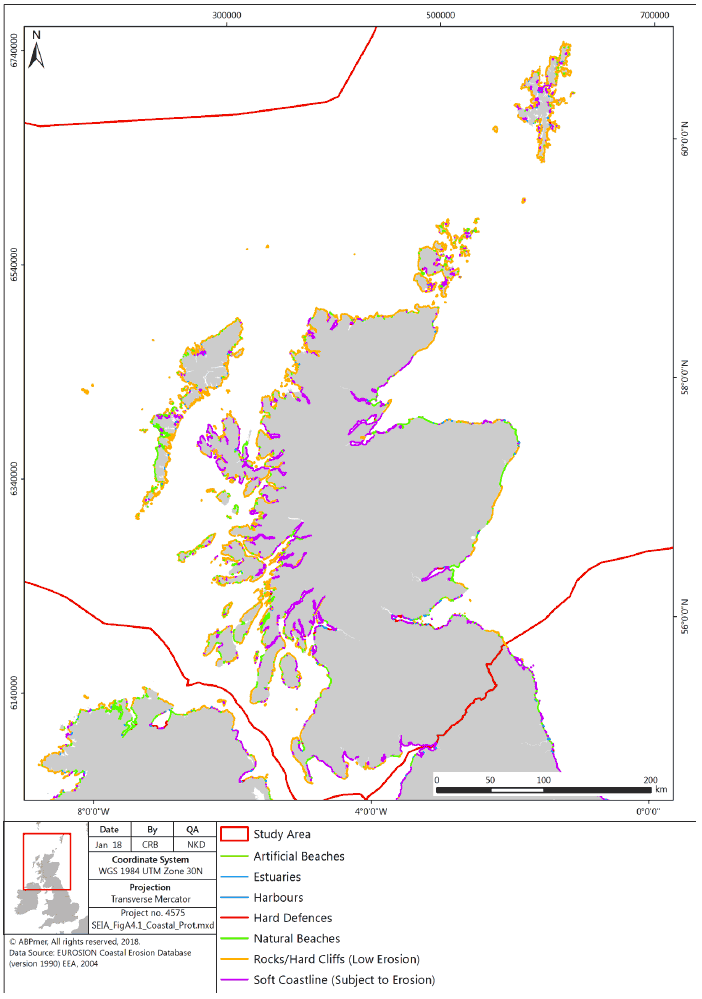Sectoral marine plan for offshore wind energy: social and economic impact assessment scoping report
Sets out the methodology and scenarios for scoping and undertaking a socio-economic impact assessment.
A.5. Coast Protection and Flood Defence
A.5.1 Sector Definition
This sector relates to the land-based activity of coastal defence, which influences the marine environment. Coastal protection and flood defence measures are used to prevent or reduce flood risk and coastal erosion. Examples of coastal and flood defences include groynes, sea walls and embankments, termed 'hard engineering', and beach replenishment, managed retreat and coastal realignment, termed 'soft engineering'.
A.5.2 Overview of Activity
Both hard and soft flood protection and coastal defence assets are generally located in or adjacent to intertidal areas and therefore their extent is limited to a narrow margin around the coastline ( Figure A.5.1). Hard engineering defences include sea walls, groynes and rock armour, while soft engineering options include beach replenishment and managed realignment.
In 2004, the EUROSION project estimated that 733 km of Scotland's coastline was protected by defence works and artificial beaches ( EUROSION, 2004), while Scottish Natural Heritage ( SNH) estimated that 307 km of Scotland's mainland coast is comprised of coastal defences (Baxter et al. 2011).Scotland's Marine Atlas (Baxter et al, 2011) provides details of flood defence and coast protection schemes in Scotland, which at that time included 14 flood defence schemes (since 1961), 10 coast protection schemes (since 2000) and 2 managed realignment schemes.
Coastal protection and flood prevention schemes do not contribute directly to the economy and hence it is not possible to assign an economic value to this sector. However, the main benefit of flood defence and coastal protection schemes is the protection of property and reduced damage to economically important land and infrastructure (Baxter et al. 2011). Foresight (2004; cited in Masselink and Russell, 2013) estimated that the cost of damage due to coastal erosion in the UK was £15 million per year which, in the worst case, may rise to £126 million per year by 2080.
Future sea level rise and the potential for increasingly severe storm events due to climate change may place Scotland's coastal infrastructure and habitats under increasing threat and hence increase the economic importance of this sector ( UKMMAS, 2010; Baxter et al. 2011).
Figure A.5.1 shows an overview of the types of coastal protection and flood defence schemes in Scotland. Information sources that can be used in the assessment are listed in Table A.5.1.
Figure A.5.1 Coastal protection schemes

Table A.5.1 Information sources for coastal protection and flood defence sector
| Data Available | Information Source |
|---|---|
| Locations of soft and hard engineered flood defence schemes (Europe/Scotland) | EUROSION: http://www.eurosion.org/ |
| Locations of soft and hard engineered flood defence schemes in Scotland | Baxter et al. 2011 |
A.5.3 Potential Interactions with Offshore Wind
Table A.5.2 shows potential interaction pathways between coastal protection and flood defence and offshore wind arrays and export cables. Based on the approach to scoping described in Section 2 in the main report, the table also records whether the interaction:
- Is not likely to result in a significant socio-economic impact on the sector; or
- Is likely to result in a significant socio-economic impact on the sector and hence will require a detailed assessment;
The rationale underlying this expert judgement is provided in the table. Where it is not currently possible to make a judgement regarding the likelihood of a significant socio-economic impact due to insufficient information (for example, in relation to the extent of overlap between a sector activity and the DPO Areas) the table indicates that scoping will be required to be undertaken once sufficient information becomes available. Furthermore, as described in the main report, there is currently no information regarding the likely location of export cable routes/corridors and as such, it is not possible to undertake a meaningful assessment of the potential for any sector activity/export cable interaction to give rise to significant socio-economic effects. Rather, the potential for any interaction will be identified in Regional Locational Guidance.
Table A.5.2 Potential interaction pathways
| Potential Interaction |
Technology Aspect and Phase |
Potential Socio-economic Consequences |
Initial Scoping Assessment |
|---|---|---|---|
| Potential for increased erosion, depending on location and design of array |
Array (construction and operation) |
Damage to property, infrastructure or economically important land |
The cumulative impact of offshore wind development, including floating wind arrays, on coastal processes at the coast is a current knowledge gap. Applying broad assumptions and criteria at a Sectoral level is likely to provide inaccurate results. Instead it is recommended that the economic consequences are discussed at project-level. This should be based on the output of wave modelling studies and in consultation with relevant stakeholders as part of the EIA scoping and consultation process. No detailed assessment possible. |
| Overlap between export cable landfall and coast protection and flood defence infrastructure |
Export cables (construction) |
Damage to property, infrastructure or economically important land due to reduced protection/defence of the coastline from erosion and flooding |
Export cable routes are uncertain and constraints inshore of DPOs will be identified in the RLG. It is considered that there is scope for the export cable corridor to avoid sections of coastline with coastal protection and/or flood defence infrastructure ( i.e. areas sensitive to erosion/flooding). Alternatively, should the landfall unavoidably overlap with such infrastructure, it is assumed that it would be repaired/replaced upon completion of the works. No detailed assessment required. |
A.5.4 Scoping Methodology
No detailed assessment is required in relation to impacts from export cable landfall. Any potential impact related to erosion/flooding at the coast arising from offshore arrays should be assessed at project level via EIA.
A.5.5 Data Limitations
There is limited publically available information relating to the location, costs and expenditure in relation to recent flood defence and coastal protection developments in Scotland.
Contact
There is a problem
Thanks for your feedback